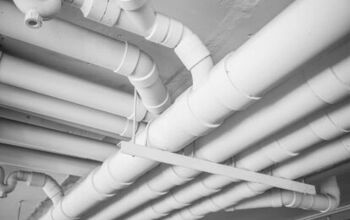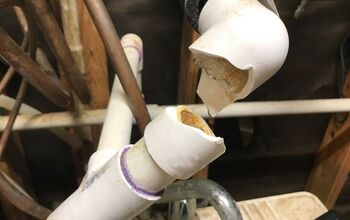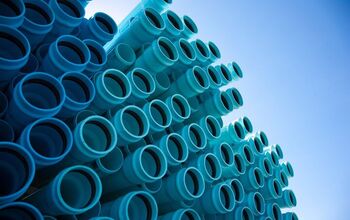How Much Weight Will PVC Pipe Support? (Find Out Now!)

PVC pipe is a versatile product with more uses than conveying liquids from point A to B. Many people use PVC pipe to build shelves, furniture, and even garden structures such as greenhouse frames. Often these people wonder how much weight PVC pipe will support.
PVC pipes weight-bearing strength is called tensile strength. The tensile strength of PVC pipe is directly proportional to its diameter. Typically, the larger the diameter of the pipe, the more tensile strength the pipe exhibits. The length of the section of PVC pipe is a factor in its weight-bearing capabilities.
Before you begin to build a project with PVC pipe, it is a good idea to determine the tensile strength of the pipe you are using. PVC pipe is available in different styles and weights. Schedule 40 PVC pipe is the most common, but Schedule 80 follows close. There are other types, such as DWV and foam core PVC pipe. Understanding the capabilities of these PVC products can save you some problems as you build your PVC pipe project.
Do You Need a Faucet, Fixture, or Pipe Repair or Replacement?
Get free, zero-commitment quotes from pro contractors near you.

Finding the Right Size to Weight Ration for your Project
Finding the perfect size-to-weight ratio for your PVC project is critical for several reasons. You should take into consideration these factors.
- Factor the maximum weight you expect your project to encounter and size the PVC with a ten percent load-bearing safety margin.
- Try to keep the PVC pipe diameter as small as possible to meet your weight-bearing requirements. This can be a budget factor.
- Choose the correct type of PVC pipe for your project. Cost is another consideration here.
- The size of your project (height, depth, and width) can have a big impact on its weight-bearing ability. Long PVC pipe runs tend to sag and bend.
A properly planned PVC pipe project can provide years of service. Remember that undersized projects get overloaded and fail, sometimes with catastrophic results. This chart may help you determine the best diameter of the pipe for your project.
Span and Deflection of PVC Pipe
| Span in Feet | ½” PVC Pipe | ¾” PVC Pipe | 1” PVC Pipe | 1.25” PVC Pipe | 1.5” PVC Pipe | 2” PVC Pipe |
| 1′ | 18 lb. | 28 lb. | 40 lb. | 50 lb. | 58 lb. | 70 lb. |
| 2′ | 5 lb. | 10 lb. | 24 lb. | 35 lb. | 45 lb. | 55 lb. |
| 3′ | 3 lb. | 6 lb. | 11 lb. | 20 lb. | 30 lb. | 35 lb. |
| 4′ | 2 lb. | 3 lb. | 6 lb. | 11 lb. | 23 lb. | 28 lb. |
Spans longer than four feet are not recommended. Deflection of the PVC pipe becomes a problem with longer spans which can cause structural issues with your project.
PVC Pipe Options
You should understand the various options available in your local home improvement store PVC pipe section. These different types of PVC pipe often have different tensile strengths. Choosing the wrong pipe for your project can have catastrophic results.
PVC-U – The Cheap and Common Option
For most run-of-the-mill non-plumbing projects, PVC-U is a great choice. This type of PVC pipe is usually the least expensive and readily available. PVC-U doesn’t contain any type of plasticizer or other additives. PVC-U is also quite UV resistant and durable.
C-PVC – For Higher Temperatures
When PVC pipe may have to withstand a wider range of temperatures, the pipe is chlorinated during the manufacturing process. This makes the pipe more suitable for use in water systems that include a water heater and must deliver hot water to taps and other sources. C-PVC is the most common PVC pipe used in residential plumbing.
PVC-O
When PVC-U undergoes a special type of processing, the plastic molecules become oriented to provide more strength. This makes PVC-O a much stronger and more pressure-resistant plastic pipe. Underground pressure pipes for water mains are primary uses for PVC-O.
PVC-HI
PVC pipe can be modified with certain additives that increase the plastic pipe’s resistance to impacts and other external damage. Many PVC pipe applications specify PVC-HI as the acceptable PVC product. PVC-HI pipe must meet a much higher standard of manufacture and testing to receive the High Impact rating. Pipelines that transport natural gas under pressure are usually constructed with PVC-HI.
What is the Best PVC Pipe for my DIY Project?
In general, PVC-U or C-PVC are the most used types of PVC pipe for home projects that don’t involve moving water. For example, many people build shelving, furniture, or garden projects using PVC-U and C-PVC.
Typically, the cost is a major factor for these types of projects. PVC-U is typically a little less expensive than C-PVC and works just as well. This may or may not be a big concern, depending on the size and complexity of your project.
Another consideration is availability. Most home improvement centers stock PVC-U and C-PVC pipe and fittings. However, finding specialty fittings such as 4-way T’s and other connectors may be harder for C-PVC.
Do I Need Special Glue for Building My Project?
Some types of plastic pipe require specialized solvent glues to make the joints secure. Using PVC pipe typically requires standard PVC solvent. However, there are some tricks to making solid connections that won’t leak.
- Make sure the PVC is clean. Wipe off any dust or other debris from the end of the pipe and inside the fitting. If necessary, use a damp rag to clean the two surfaces.
- Clean off any burrs or plastic chips from the pipe and fitting. A small rasp or file is a handy tool for this. Smaller diameter PVC pipe may be prepared with plumbers emery cloth or fine sandpaper
- Apply primer to the outside of the pipe and the inside of the fitting. The primer begins the solvent weld process by softening the PVC surface. If you are worried about keeping the new white color of your pipe, you can purchase clear PVC primer.
- Let the primer dry to the touch before applying the solvent cement to the pipe and fitting. Use the applicator in the cement can and apply an even coat of solvent cement to the pipe and fitting. Try to avoid drips and runs.
- Immediately fit your pipe and fitting together. Slip the fitting on the pipe and push until the pipe hits the stop inside the fitting. Give the fitting a quarter turn to ensure the solvent cement is spread evenly. Hold the fitting and pipe together securely for a few minutes to allow the solvent weld to cure.
‘Properly made solvent cement joints are often stronger than the pipe and fitting. For example, a solvent cement joint should last longer than the pipe and fitting under normal use.
Do You Need a Faucet, Fixture, or Pipe Repair or Replacement?
Get free, zero-commitment quotes from pro contractors near you.

PVC Pipe Projects – Fun and Economical
PVC pipe can be adapted to a wide range of projects other than just moving water from here to there. Your imagination limits what you can accomplish with some PVC pipe and a few fittings. Remember that the pipe’s length and its diameter create the weight limits your project can carry.

Dennis is a retired firefighter with an extensive background in construction, home improvement, and remodeling. He worked in the trades part-time while serving as an active firefighter. On his retirement, he started a remodeling and home repair business, which he ran for several years.
More by Dennis Howard



























